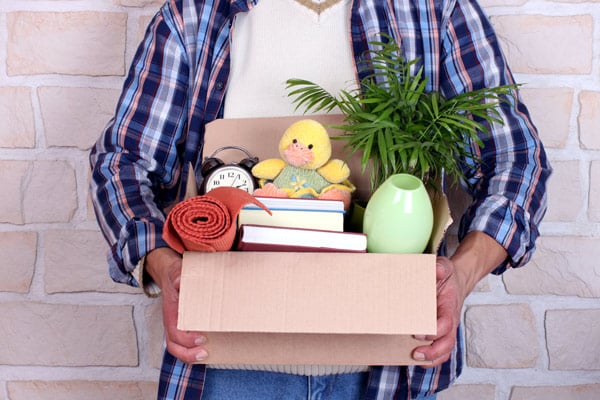So, moving day is over and you finally arrive in your new home – relieved, but totally drained. You need a relaxing shower, a healthy meal, and a good sleep – and you need them as soon as possible.
Yet, there will be no toiletries and towels in the bathroom, no plates and glasses in the kitchen, and no sheets on the bed – you’ll need to unpack some essential items before you can have a shower, dinner, or rest.
You will, however, have no energy to rummage through the boxes to find what you need – not to mention that your shipment may not have been delivered yet, so there may be no boxes to look through.
That’s why it’s very important to prepare a first night box for moving – a box that contains the essentials you’re going to need on the first day and night in your new home.
This essentials box will make things easier on move-in day and during the first days after the move – and, in the event of a cross country move, it will help you survive until your goods arrive.
Read on to find out what an essentials box for moving is and what to pack in it:
What is a first night box when moving?
As its name suggests, a first night moving box is a box that contains some crucial items you’re going to need immediately after arriving in your new home and on the first night you spend in it.
Having all your essentials packed together in a single box will come in very handy after the exhausting moving day. And if you arrive in your new place before your items (as is often the case when moving long distance), your essentials box will help you survive for some time without the rest of your belongings.
Important! Make sure your first night box travels with you so you have your essentials at hand when you get to your new home.
What to pack in your first night box?
You can’t really pack everything you might need for the first several days in your new home in a single box, so you should focus on the absolute essentials:
- Personal documents – passports, birth certificates, driver’s licenses, credit cards, social security cards, professional certificates, medical records, your kids’ school records (if applicable), your pets’ vet records (if applicable), etc.;
- Personal care items – toothbrush and toothpaste, hair products and hair brushes, skin care products, cosmetics, etc.;
- Prescription medicines and personal medical items;
- Nightwear;
- A change of clothes, extra socks and underwear, and a pair of extra shoes;
- A set of bed linens;
- A bath towel;
- Personal electronic devices with their charges and adapters (as applicable) – phones, tablets, laptops, music players, etc.;
- Any other items that you want to have with you on the first night in your new place – comfort items, entertainment items, special items you don’t want to part with, etc.
Every family member should have their own box of essentials.
Important! If you’re moving with children, be sure to include their favorite toys and books, as well as some games and other age-appropriate entertainment items, in their essentials boxes – to keep your kids happy and occupied during the trip to your new home and in the time it takes to set up your new place. Keep in mind that younger children will need their comfort items in order to feel safer in the new environment.
If you have school-aged children and you’re moving long distance during the school year, include your kids’ school items in their essentials boxes too (in case the moving truck gets delayed).
If you have a baby, you will, of course, need to pack a bag of specialized baby items.
Be sure to bring plenty of your kids’ favorite snacks and beverages as well.
How to prepare essentials boxes for moving?
In addition to the personal essentials boxes every family member should have, you need to pack an open-first box (or a couple of boxes) with some basic necessities:
- Bottled water;
- Some non-perishable food and plenty of healthy snacks – a jar of jam, a jar of peanut butter, canned meats and vegetables, some pasta and pasta sauce, cereals, cheese crackers, nuts, dried fruits, a bag of bagels, etc.;
- Basic kitchen items – plates, cups, and eating utensils for everyone, an all-purpose cutting knife, a can-opener and a bottle-opener, dish soap, paper towels, etc. If you’re driving to your new home, consider taking some small kitchen appliances as well – a coffee maker (and coffee, of course), a toaster, etc.;
- Bathroom essentials – toilet paper, hand soap, hand towels, hair dryer, shower curtain, etc.;
- Medications – first-aid kit, pain relievers, allergy meds, vitamins, etc.;
- Basic cleaning supplies – an all-purpose cleaner, some sponges and rags, wet wipes, trash bags, etc. If you’re traveling by your car, take a broom, a mop, and a bucket, too;
- Basic tools – a toolbox, as well as a pocket knife, a pair of scissors, a flashlight, and some batteries;
- Pet items (if applicable) – pet food, food and water bowls, grooming items, your pets’ bedding and favorite toys, etc.
Everyone’s situation is different, of course, so you need to create your own customized moving essentials box list – what exactly you’re going to pack in your open-first boxes will depend on your particular needs and preferences, as well as on your method of travel (you’ll be able to take many more items with your car than if you were flying). Just be sure to take everything you’re going to need to ensure good hygiene and good night’s sleep, have a decent meal, and deal with minor emergencies in the first couple of days in your new home.
Important! When moving long distance, have in mind that you may need to wait for a week or more for your belongings to be delivered and pack your essentials boxes accordingly.
Bonus tips for packing an essentials box for moving
In order to pack your essentials boxes in the safest and most efficient way possible, you’re advised to:
- When sorting out your items before the move, set aside the essentials you’re going to include in your first night moving box.
- Seal containers with liquids well and put them in sealable plastic bags before packing them in your essentials box to avoid leakage and staining.
- Use padding materials to ensure the items in your essentials boxes are well cushioned and can’t shift around during the move.
- Pack the items you’re going to need immediately after arriving in your new home at the top of your first-night box.
- Do not seal your essentials box until it’s time to leave your old home – you may need to take something out of it or put an additional item in it at the last moment.
- Make a list of emergency phone numbers and secure it to the top of your essentials box.
- Label your open-first boxes properly and keep them away from your other boxes, so they don’t get accidentally loaded on the moving truck.
Important! Be sure to take your jewelry and other extremely valuable items with you as well, even though you’re unlikely to need them in the first days after the move. If you’re driving to your new home, transport your expensive electronics, pieces of art, family heirlooms, collectibles, and other items of high sentimental or monetary value in your car – so there’s no risk of them getting damaged or lost during the move.









